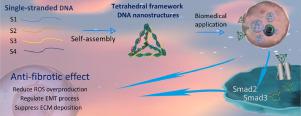Applied Materials Today ( IF 7.2 ) Pub Date : 2020-06-13 , DOI: 10.1016/j.apmt.2020.100725 Tianxu Zhang , Yang Gao , Dexuan Xiao , Junyao Zhu , Mi Zhou , Songhang Li , Mei Zhang , Yunfeng Lin , Xiaoxiao Cai

|
As a type of novel biomaterial, DNA nanomaterial has been widely applied to biomedical area due to its self-assembly properties. Meanwhile, fibrotic diseases are common health problems, which can lead to multiple organs dysfunction and even death if without proper intervention and treatment. Therefore, we aim to develop the nucleic acids based tetrahedral framework DNA nanostructures (TFNAs) for the treatment of fibrotic diseases. Four single-strand DNA were self-assembled to form tetrahedral framework DNA nanostructures and the anti-fibrotic effects of TFNAs were investigated with an in vitro TGF-β1-induced fibrotic model. TFNAs were successfully assembled and showed obvious cellular uptake. After TFNAs treatment, ROS overproduction, fibrosis-related biomolecules expression including collagen I, fibronectin and α-SMA were obviously reduced. DNA-based TFNAs could be promising biomaterials for the treatment of fibrotic diseases.
中文翻译:

基于核酸的四面体框架DNA纳米结构,用于纤维化疾病的治疗
DNA纳米材料作为一种新型的生物材料,由于其自组装特性而被广泛应用于生物医学领域。同时,纤维化疾病是常见的健康问题,如果没有适当的干预和治疗,会导致多器官功能障碍甚至死亡。因此,我们旨在开发基于核酸的四面体框架DNA纳米结构(TFNAs),用于治疗纤维化疾病。四个单链DNA自组装形成四面体框架DNA纳米结构,并在体外研究了TFNA的抗纤维化作用TGF-β1诱导的纤维化模型。TFNAs已成功组装并显示出明显的细胞摄取。TFNAs处理后,ROS的过量产生,与纤维化相关的生物分子表达,包括胶原蛋白I,纤连蛋白和α-SMA的表达均明显降低。基于DNA的TFNAs可能是治疗纤维化疾病的有前途的生物材料。









































 京公网安备 11010802027423号
京公网安备 11010802027423号